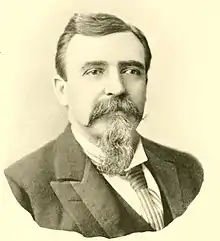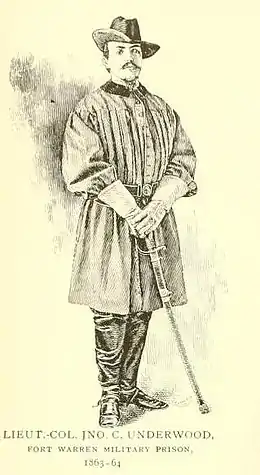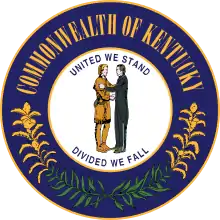John C. Underwood
John Cox Underwood (September 12, 1840 – October 29, 1913)[1] was an American civil engineer, Confederate veteran, journalist and the 21st Lieutenant Governor of Kentucky (serving in that capacity from 1875 to 1879).[2]
John C. Underwood | |
|---|---|
 | |
| 21st Lieutenant Governor of Kentucky | |
| In office August 31, 1875 – September 2, 1879 | |
| Governor | James B. McCreary |
| Preceded by | John G. Carlisle |
| Succeeded by | James E. Cantrill |
| Personal details | |
| Born | September 12, 1840 Georgetown, Washington, D.C. |
| Died | October 29, 1913 (aged 73) Manhattan, New York |
| Military service | |
| Allegiance | |
| Branch/service | Army engineer |
| Years of service | 1862-3 |
| Rank | corporal |
| Unit | Breckinridge's Division, Engineer Corps |

Early and family life
Underwood was born in Georgetown, Washington, D.C.[3] on September 12, 1840, the son of U.S. Representative Joseph Rogers Underwood (1791-1876) and his second wife, Elizabeth Threlkeld Cox (1818-1884). His grandfather John Cox (1775-1849) was the mayor of Georgetown (and a slaveholder) from 1823 until 1845,[4] before it was annexed into Washington, D.C. He attended local private schools, then Rensselaer Polytechnic Institute in New York City, from which he received a civil engineering degree in 1862.
He married Drucilla Duncan Underwood (1844-1905) and they had two daughters, Helen Underwood Hine (1873-1958), and her sister Drucilla Underwood Grant.
Career
After graduation, although his father was a Unionist, John Underwood enlisted in Breckenridge's Division, Engineer Corps of the Confederate States Army, and served in Virginia and Tennessee. His uncle John Threlkeld Cox (1820-1886) was also a civil engineer and led several different Confederate cavalry brigades, mostly of Kentucky volunteers.[5] Young John Underwood soon contracted typhoid fever, and was captured in 1863 at Tullahoma, Tennessee. Imprisoned in Cincinnati and Boston, he received a parol from President Abraham Lincoln.[6]
After the American Civil War, Underwood became Bowling Green's City Engineer, and designed Fountain Square Park. He also served as Bowling Green's mayor in 1870-71 and edited newspapers in Bowling Green, Cincinnati and Louisville. He was a member of the Odd Fellows, and was elected Lieutenant Governor under Governor James B. McCreary. However, his bid to become Kentucky's governor in 1879 failed, and Luke P. Blackburn of Louisville received the nomination.
For the rest of his Life, Underwood was devoted to genealogy and the Lost Cause of the Confederacy through the United Confederate Veterans. He raised money to construct a Confederate Memorial at Oak Woods Cemetery in Chicago, Illinois to commemorate the Confederate prisoners who died at Camp Douglas, and whose remains were exhumed and moved there after closure of the previous cemetery and expansion of Grant Park during urban renewal following the Great Chicago Fire of 1871.
Underwood then agreed to raise money for a Confederate monument in Richmond, Virginia.[7] However, the project was embroiled in legal controversies which ruined him financially and physically. In 1910, oil portraits of many of the twenty Confederate generals he had commissioned from E.F. Andrews were auctioned by a Covington, Kentucky warehouse to pay storage fees, and most ended up in Virginia.[8] By that time, Underwood's wife had died and he lived in Manhattan, New York and described himself in the census as an author.[9]
Death and legacy
John Cox Underwood died on October 29, 1913 in Manhattan, New York City. His remains were returned to Kentucky for burial in the family plot at Fairview cemetery in Bowling Green.
Western Kentucky University has several of his commissioned paintings and maintains some of his papers (as well as those of his Unionist father and paternal uncle), including letters available online.[10][11]
References
- Threlkeld, Hansford Lee (1932). "Threlkeld genealogy".
- Nancy D. Baird, "John Cox Underwood" in John E. Kleber (ed.), The Kentucky Encyclopedia (University Press of Kentucky) pp. 905-906
- Western Kentucky University and the Kentucky encyclopedia disagree as to whether he was born in Washington, D.C.'s Georgetown or Georgetown, Kentucky.
- http://gloverparkhistory.com/estates-and-farms/cedars/john-cox/
- Bruce C. Allardice, Confederate Colonels: a Biographical Register (University of Missouri Press 2008), p. 112 available at https://books.google.com/books?id=r1E1FTjEfIkC&pg=PA112&lpg
- http://digitalcommons.wku.edu/cgi/viewcontent.cgi?article=2678&context=dlsc_mss_fin_aid
- Minutes of the 9th annual meeting of the United Confederate Veterans at p. 173 et seq. available at https://books.google.com/books?id=n1krAQAAMAAJ&pg=PA173&lpg#v=onepage&q&f=false
- Nancy D. Baird, "John Cox Underwood" in John E. Kleber (ed.), The Kentucky Encyclopedia (University Press of Kentucky) pp. 905-906
- 1910 U.S. federal census for Manhattan
- https://westernkentuckyuniversity.pastperfectonline.com/byperson?keyword=Underwood%2C+John+Cox%2C+1840-1913
- http://digitalcommons.wku.edu/cgi/viewcontent.cgi?article=2678&context=dlsc_mss_fin_aid
| Political offices | ||
|---|---|---|
| Preceded by John G. Carlisle |
Lieutenant Governor of Kentucky 1875–1879 |
Succeeded by James E. Cantrill |

